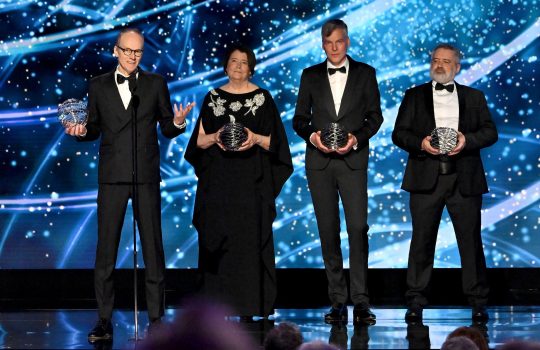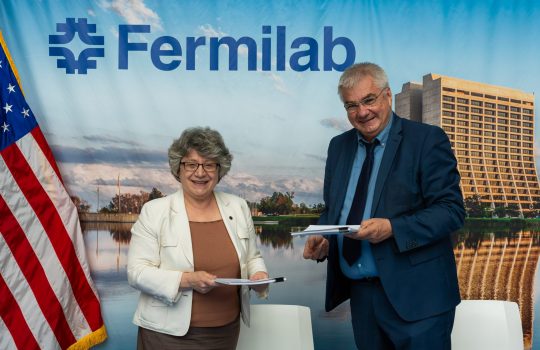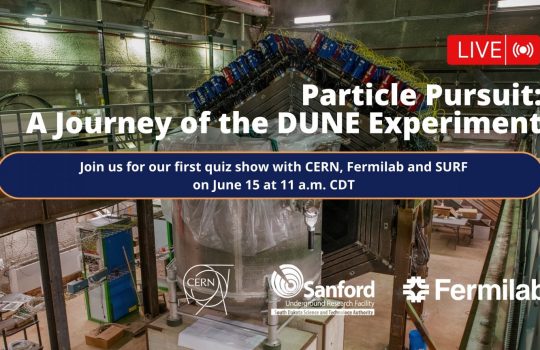BATAVIA, Illinois — Two experiments at the Large Hadron Collider have nearly eliminated the space in which the Higgs boson could dwell, scientists announced in a seminar held at CERN today. However, the ATLAS and CMS experiments see modest excesses in their data that could soon uncover the famous missing piece of the physics puzzle.
The experiments revealed the latest results as part of their regular report to the CERN Council, which provides oversight for the laboratory near Geneva, Switzerland.
Theorists have predicted that some subatomic particles gain mass by interacting with other particles called Higgs bosons. The Higgs boson is the only undiscovered part of the Standard Model of physics, which describes the basic building blocks of matter and their interactions.
The experiments’ main conclusion is that the Standard Model Higgs boson, if it exists, is most likely to have a mass constrained to the range 116-130 GeV by the ATLAS experiment, and 115-127 GeV by CMS. Tantalising hints have been seen by both experiments in this mass region, but these are not yet strong enough to claim a discovery.
Higgs bosons, if they exist, are short-lived and can decay in many different ways. Just as a vending machine might return the same amount of change using different combinations of coins, the Higgs can decay into different combinations of particles. Discovery relies on observing statistically significant excesses of the particles into which they decay rather than observing the Higgs itself. Both ATLAS and CMS have analysed several decay channels, and the experiments see small excesses in the low mass region that has not yet been excluded .
Taken individually, none of these excesses is any more statistically significant than rolling a die and coming up with two sixes in a row. What is interesting is that there are multiple independent measurements pointing to the region of 124 to 126 GeV. It’s far too early to say whether ATLAS and CMS have discovered the Higgs boson, but these updated results are generating a lot of interest in the particle physics community.
Hundreds of scientists from U.S. universities and institutions are heavily involved in the search for the Higgs boson at LHC experiments, said CMS physicist Boaz Klima of the Department of Energy’s Fermi National Accelerator Laboratory near Chicago. “U.S. scientists are definitely in the thick of things in all aspects and at all levels,” he said.
More than 1,600 scientists, students, engineers and technicians from more than 90 U.S. universities and five U.S. national laboratories take part in the CMS and ATLAS experiments, the vast majority via an ultra-high broadband network that delivers LHC data to researchers at universities and national laboratories across the nation . The Department of Energy’s Office of Science and the National Science Foundation provide support for U.S. participation in these experiments. Fermi National Accelerator Laboratory is the host laboratory for the U.S. contingent on the CMS experiment, while Brookhaven National Laboratory hosts the U.S. ATLAS collaboration.
Over the coming months, both the CMS and ATLAS experiments will focus on refining their analyses in time for the winter particle physics conferences in March. The experiments will resume taking data in spring 2012.
“We’ve now analyzed all or most of the data taken in 2011 in some of the most important Higgs search analyses,” said ATLAS physicist Rik Yoshida of Argonne National Laboratory near Chicago. “I think everybody’s very surprised and pleased at the pace of progress.”
Higgs-hunting scientists on experiments at U.S. particle accelerator the Tevatron will also present results in March.
Discovering the type of Higgs boson predicted in the Standard Model would confirm a theory first put forward in the 1960s.
Even if the experiments find a particle where they expect to find the Higgs, it will take more analysis and more data to prove it is a Standard Model Higgs. If scientists found subtle departures from the Standard Model in the particle’s behavior, this would point to the presence of new physics , linked to theories that go beyond the Standard Model. Observing a non-Standard Model Higgs, currently beyond the reach of the LHC experiments with the data they’ve recorded so far , would immediately open the door to new physics .
Another possibility, discovering the absence of a Standard Model Higgs , would point to new physics at the LHC’s full design energy, set to be achieved after 2014. Whether ATLAS and CMS show over the coming months that the Standard Model Higgs boson exists or not, the LHC program is closing in on new discoveries.
Notes for editors:
Media contacts:
Brookhaven National Laboratory – Karen McNulty Walsh, kmcnulty@bnl.gov, 631-344-8350
Fermi National Accelerator Laboratory – Tona Kunz, tkunz@fnal.gov, 630-840-3351
Information about the US participation in the LHC is available at http://www.uslhc.us. Follow US LHC on Twitter at twitter.com/uslhc.
Brookhaven National Laboratory is operated and managed for DOE’s Office of Science by Brookhaven Science Associates and Battelle. Visit Brookhaven Lab’s electronic newsroom for links, news archives, graphics, and more: http://www.bnl.gov/newsroom.
Fermilab is a U.S. Department of Energy Office of Science national laboratory, operated under contract by the Fermi Research Alliance, LLC. Visit Fermilab’s website at http://www.fnal.gov.
The DOE Office of Science is the single largest supporter of basic research in the physical sciences in the United States, and is working to address some of the most pressing challenges of our time. For more information, please visit http://science.energy.gov.
The National Science Foundation focuses its LHC support on funding the activities of U.S. university scientists and students on the ATLAS, CMS and LHCb detectors, as well as promoting the development of advanced computing innovations essential to address the data challenges posed by the LHC. For more information, please visit http://www.nsf.gov/.
CERN, the European Organization for Nuclear Research, is the world’s leading laboratory for particle physics. It has its headquarters in Geneva. At present, its Member States are Austria, Belgium, Bulgaria, the Czech Republic, Denmark, Finland, France, Germany, Greece, Hungary, Italy, the Netherlands, Norway, Poland, Portugal, Slovakia, Spain, Sweden, Switzerland and the United Kingdom. Romania is a candidate for accession. Israel is an Associate Member in the pre-stage to Membership. India, Japan, the Russian Federation, the United States of America, Turkey, the European Commission and UNESCO have Observer status.
Photos:
Click here for photos.
Background videos and information:
What is a Higgs boson? http://www.youtube.com/user/fermilab#p/u/3/RIg1Vh7uPyw
How do we search for Higgs bosons?
http://www.youtube.com/user/fermilab#p/u/0/1GrqMCz_vnA
Backgrounders on the Higgs boson search:
http://press.web.cern.ch/press/background/B01-Higgs_en.html
http://press.web.cern.ch/press/background/B10-Higgs_evolution_or_revolution_en.html
Definitions of important terms: http://press.web.cern.ch/press/background/B09-Important_Higgs_terms_en.html
Videos from CERN (available at 9:30 a.m. CST, 10:30 a.m. EST):
A roll: https://cdsweb.cern.ch/record/1406052
B roll: https://cdsweb.cern.ch/record/1406051
Further information:
From ATLAS: http://www.atlas.ch/news/2011/status-report-dec-2011.html
From CMS: http://cms.web.cern.ch/news/cms-search-standard-model-higgs-boson-lhc-data-2010-and-2011



